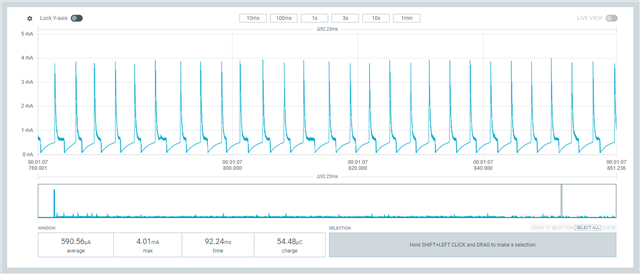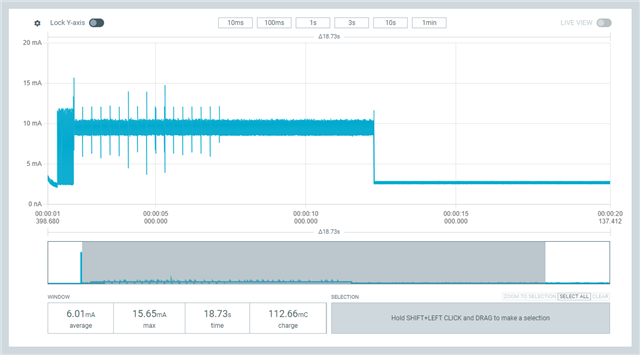NCS 2.4.1
nRF52840
My project is a battery powered SED based on the coap_client example. It is configured to autojoin using a hard coded pksd. I see on Wireshark that my device sends one Discovery Request when it starts up (if it is not already commissioned). I am testing a situation where there is no commissioner. The device should try to join, but then go to sleep after 5 minutes until awakened by the user which will cause a reboot.
I need it to go into a low power mode once the joiner times out. It does not. I see on the Power Profiler that the current is ~6mA after 5 minutes. I tried to change the link mode to set mRxOnWhenIdle to false, but the current remained high.
What is the timeout for joining when using autojoin?
Is it possible to re-try joining multiple times before giving up?
How can I force it to go into a low power sleep? Disable Thread?
prj.conf
# Thread Joiner CONFIG_OPENTHREAD_JOINER=y CONFIG_OPENTHREAD_JOINER_AUTOSTART=y CONFIG_OPENTHREAD_JOINER_PSKD="J01NUS" CONFIG_OPENTHREAD_MANUAL_START=n
main.c
int wait = 0;
while(otDatasetGetActive(instance, &dataset) != OT_ERROR_NONE)
{
wait++;
if (wait < 60) // 5 sec x 60 = 5 min
{
// wait for joining to complete, blink LED up to 5 minutes
set_led(COLOR_PURPLE); // blink purple, 5 sec
k_msleep(100);
set_led(COLOR_OFF);
k_msleep(4900);
}
else if (wait > (12 * 60)) // 5 sec x 12 x 60 = 60 min, reboot in an hour
{
LOG_INF("Active Dataset not found. Rebooting\r\n");
g_reboot = true;
}
else
{
otError error;
otLinkModeConfig mode;
struct openthread_context *context = openthread_get_default_context();
__ASSERT_NO_MSG(context != NULL);
openthread_api_mutex_lock(context);
mode = otThreadGetLinkMode(context->instance);
if (mode.mRxOnWhenIdle) // disable receiver
{
mode.mRxOnWhenIdle = false;
error = otThreadSetLinkMode(context->instance, mode);
}
openthread_api_mutex_unlock(context);
k_msleep(5000);
}
if (g_reboot)
k_work_submit(&reboot_work);
}
Thanks,
Mary




